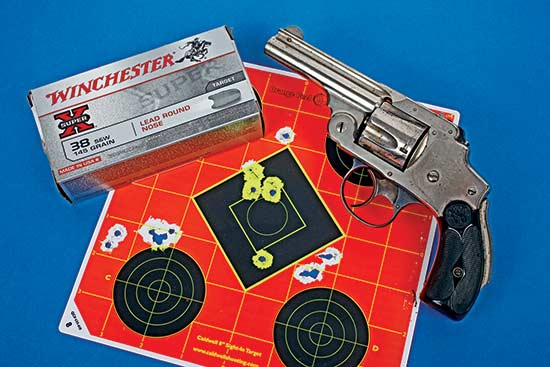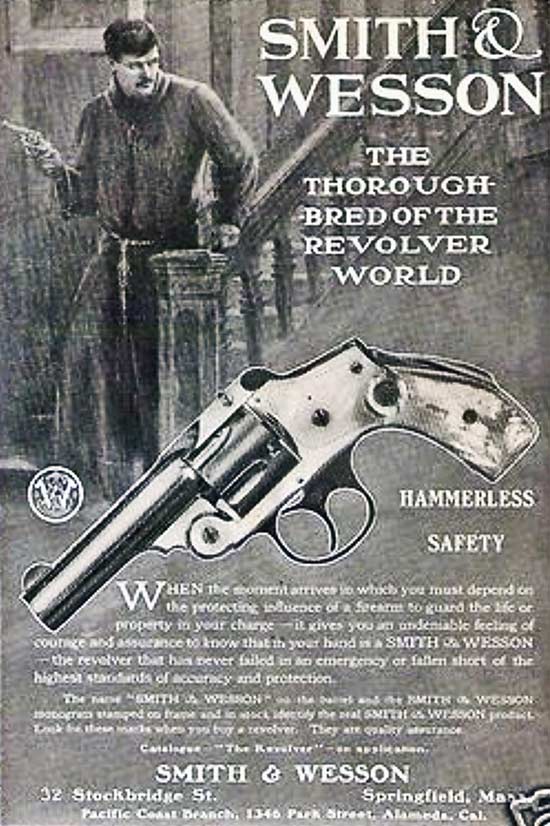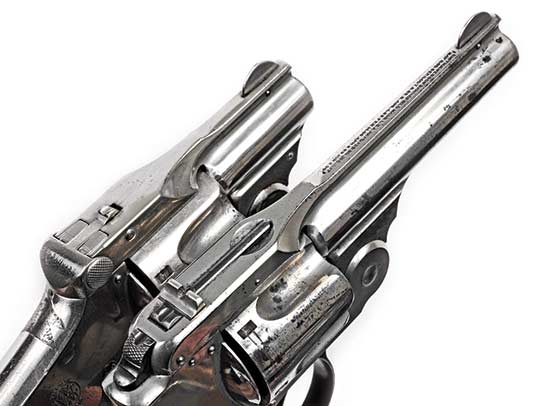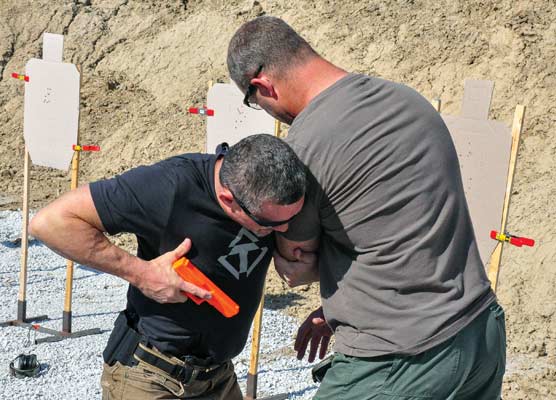Revolver Redo
A Break-Top Binge
Other than making them go bang a few times for fun, it dawned on me I had never actually targeted one of the old break-top revolvers. Their reputations run the gamut from those dreadful South American ones, to “modern” S&Ws from the turn of the century and a bit after. I once saw a South American break-top looking like an S&W DA from the teens. It was labeled: “Smill & Welson, Sprangfeld, Mus, EUA” on the top of the barrel. Those big sneaks.
I dug out my “box” of break-tops. You know, the ones I always score from Brandon’s here in Joplin. “If it’s stupid, broken or a weird caliber, I sell it to Roy,” Brandon always says proudly. I pulled out a pretty decent S&W DA .38 S&W Safety Hammerless 3rd Model, 3.5″ barrel — actually, a nice, tight, “real” gun showing classic S&W quality workmanship. While digging, I caught another glint of nickel and remembered I had a nice version of essentially the same gun, but with a very short 1.5″ barrel, also in .38 S&W. It’s an old family heirloom my dad actually used to carry now and again when I was a kid.
I also found a 4th Model .32 Top Break, also a Smith, more along the lines of the typical .32 S&W nightstand gun our great grandparents might have had. But quality is still up to snuff for what it is. Then, digging deeper, past the missing cylinders, broken hammer spurs and cracked grips, I found a fairly intact Iver Johnson Safety Automatic I forgot I had. I did a bit of quick research and found it was likely made sometime between 1894-1896, to the tune of about $4 to $6 each. It also has a trigger safety lever like a Glock has! Ha!
But — what did you get for your money back then?
Some Surprises
I rounded up my one box of new factory .38 S&W (classic 146-gr. RNL) and about 30 .32 S&W “Western” Lubaloy rounds I found. The first target was for the longer barreled S&W and I set it up at about five yards. I stood, two-handed and practiced my best DA trigger control while peering at the essentially non-existent nickel plated sights. I honestly thought it would be hard to keep the shots on the target. Much to my absolute and utter amazement, four of the five shots went into about a 1″ group just above and to the left of the center. I pulled one shot low in the diamond. Oops. But okay, I was surprised — and it hit fairly close to point of aim.
I pushed the target out to a bit more than 10 yards and shot the lower right group. The one high flyer at the point of the diamond is because I sorta’ lost my mind on that particular trigger press. I was also becoming a bit disturbed to note, just maybe — I was completely wrong about these old guns.
I moved the target back to 15 yards and, leaning against the garage door frame, took my time aiming at the lower left bull. Again, the shots hit a bit high (I was compensating by aiming lower a bit), but you can see the five shots. Had the idiot on the trigger — that would be me — had better control of that heavy DA pull, I’m thinking the five shots would have made one ragged hole. I was learning to shoot the gun by then and am convinced to try it more later when I get more ammo. Side note: Velocity was about 616 fps over my chrono. Sloowww.
More Hard Lessons
Okay, so everyone jokes about how bad these guns are, but I was rapidly learning “everyone” might just be wrong.
Check out the pic with four targets. That’s the S&W in .38 S&W bottom right (the short-barreled gun), the .32 S&W bottom left (also a Smith), Iver Johnson .32 S&W upper left; and I tossed in a .38 S&W Enfield (1940 vintage) just for fun (upper right). I didn’t have much ammo so just shot at 12 yards, standing, leaning against that garage door frame. I put a few rounds through each gun first to get the hang of things, then targeted them.
No reason to be shy about the performance. The hitch was they all shot way off point of aim. For the snubby (lower-right) I had to aim at the top of the cardboard, as I discovered during my initial couple of test shots. Velocity was about 542 fps and I’m pretty sure I could see the bullets as they strolled leisurely toward the target.
The Enfield shot a bit high, as I aimed at the center bullseye, but the group was exceptional and the gun felt like a “real” gun. Velocity was at 627 fps. For the Iver Johnson and the lower-left S&W .32, I had to aim at the bottom of the bullseye, and even then they shot high. Velocity for the .32s hovered in the 535 fps range. I think a fast bank robber could out-run them.
You’d think gun companies might have at least roughly zeroed for the common loads of the day, but obviously not. I’m thinking the lack of decent sights and the rotten “Point Of Impact vs. Point Of Aim” situation just might be the guilty party causing everyone to think these guns shoot badly. They certainly don’t shoot badly — but they do shoot far away from where you’re aiming!
Without some experimenting, someone would likely have taken a few shots, missed badly and just assumed the gun was crapola. But fortunately for all of us, I didn’t have anything better to do; so now we’re all scratching our heads and looking at these old guns in a new light. Keep in mind, though, some of the really old ones are black powder only, and the cheaper ones are simply not up to being shot much. If you get the itch, make sure you have yours checked out first or you just might get blowed-up. Or worse.
Now … I wonder if I can take one of those pesky grey squirrels with that 3.5″ Smith? So much to do, so little time, eh?








